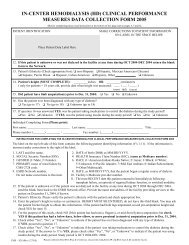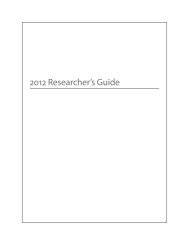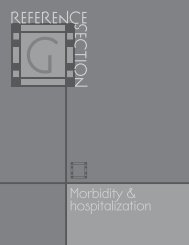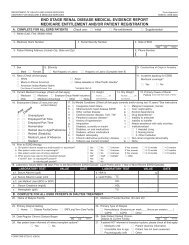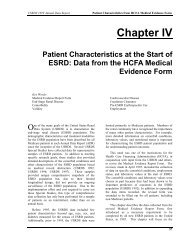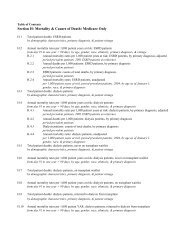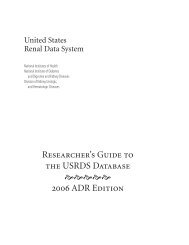2009 ADR v2 Atlas of ESRD - United States Renal Data System
2009 ADR v2 Atlas of ESRD - United States Renal Data System
2009 ADR v2 Atlas of ESRD - United States Renal Data System
Create successful ePaper yourself
Turn your PDF publications into a flip-book with our unique Google optimized e-Paper software.
5<br />
App A<br />
pg 370<br />
Time at risk is calculated differently for hospital days and total<br />
admissions. Since a hospitalized patient remains at risk for additional<br />
hospital days, rates for hospital days include hospital days<br />
in the time at risk. Since a currently hospitalized patient is not,<br />
however, at risk for new admissions, hospital days for each year<br />
are subtracted from the time at risk for total admissions. In the<br />
case <strong>of</strong> hospitalizations in which admission occurs the same day<br />
as discharge, zero days are subtracted from the time at risk for<br />
total admissions. When bridge hospitalizations span the start <strong>of</strong><br />
the analysis period, only the days within the period are subtracted<br />
from the time at risk for total admissions.<br />
All admissions and hospital days during the analysis period are<br />
included, respectively, in the total admissions and hospital days for<br />
each year. An admission for a hospitalization that occurs before<br />
and spans the start <strong>of</strong> the analysis period is excluded from the total<br />
admissions for that period, and only the hospitalization days within<br />
the period are counted in the total days for hospital day rates. The<br />
minimum length <strong>of</strong> stay is one day, and hospitalizations with an<br />
admission and discharge on the same day, as well as those with a<br />
discharge the day after admission, are both counted as one day.<br />
As in previous <strong>ADR</strong>s, all overlapping and only certain adjacent<br />
hospitalizations are combined, due to the fact that many adjacent<br />
claims may actually be legitimate separate hospitalizations. Specifically,<br />
hospitalizations with an admission on the same day or the<br />
day after a previous discharge are combined only when there is a<br />
discharge transfer code or indication <strong>of</strong> an interim claim. In the<br />
1991–2007 institutional inpatient claims, for example, 4.3 percent <strong>of</strong><br />
the hospitalizations were combined using these criteria. In the case<br />
<strong>of</strong> two hospitalizations combined into one, the principal diagnosis<br />
and procedure codes are retained from the first <strong>of</strong> the two hospitalizations,<br />
with the combined hospitalization extending from the<br />
first admission date to the last discharge date.<br />
The methodology for computing adjusted total admission and<br />
hospital day rates uses the model-based adjustment method (discussed<br />
in the statistical methods section). Predicted rates for each<br />
subgroup combination <strong>of</strong> age, gender, race, primary diagnosis, and<br />
year are obtained using a model with the Poisson assumption. For<br />
prevalent patient cohorts, this model uses data from the current and<br />
previous two years, with respective weights <strong>of</strong> 1, ¼, and ⅛. Adjusted<br />
rates are then calculated using the direct adjustment method, with<br />
all 2005 <strong>ESRD</strong> patients as the reference cohort.<br />
Tables G.11–15 show inpatient utilization in period prevalent<br />
<strong>ESRD</strong> patients. Methods — including modality definitions, inclusion<br />
criteria, data cleaning, follow-up time definitions, and rate<br />
calculations — generally follow those previously described for the<br />
total admission rates in Tables G.1–5, but some differences do exist.<br />
While patients <strong>of</strong> races other than white, African American, Native<br />
American, or Asian are excluded from G.1–5, they are included in<br />
G.11–15, except where rates are given by race. Rates are unadjusted<br />
and reflect total admissions per 100 patient years for 1999–2001,<br />
2002–2004, and 2005–2007 (pooled) prevalent patients. While the<br />
rates for all causes are computed similarly to the unadjusted rates in<br />
G.1–5, the other nine cause-specific categories only include admissions<br />
for specific diseases. Vascular access and peritoneal dialysis<br />
access hospitalizations are those classified as “pure” inpatient<br />
vascular/dialysis access events. Such access events are defined as<br />
admissions with a specified ICD-9-CM principal diagnosis code, or<br />
an ICD-9-CM principal procedure code in conjunction with a certain<br />
DRG code. Codes are listed later in this appendix in Table a.c.<br />
If an admission does not qualify as vascular/dialysis access, it is<br />
classified by the principal diagnosis code into one <strong>of</strong> eight other<br />
mutually exclusive groups. Categories and ICD-9-CM codes are as<br />
follows: circulatory diseases, 390–459; digestive diseases, 520–579;<br />
genitourinary diseases, 580–629; endocrine and metabolic diseases,<br />
240–279; respiratory diseases, 460–519; infectious diseases, 001–139;<br />
and cancer, 140–172, 174–208, 230–231, and 233–234. Hospitalizations<br />
that do not fall under any <strong>of</strong> these categories are counted<br />
under all others.<br />
Tables G.16–18 display hospital admission rates for infections<br />
including bacteremia/septicemia, pneumonia, and urinary tract<br />
infection. Rates reflect hospital admissions for the purpose <strong>of</strong> these<br />
infections and are therefore categorized by principal ICD-9-CM<br />
diagnosis codes. Codes for bacteremia/septicemia and pneumonia<br />
are listed under the discussion <strong>of</strong> Figure 6.4; codes for urinary<br />
tract infection include 590–590.9, 595–595.4, 597–597.89, 598, 599.0,<br />
601–601.9, 604–604.9, 607.1–2, 608.0, 608.4, 616.1, 616.3–4, and 616.8.<br />
Rates are unadjusted and show admissions per 100 patient years by<br />
modality for prevalent <strong>ESRD</strong> patients pooled across years.<br />
Supplementary tables providing additional rates and counts are<br />
available on our website and CD-ROM. Standardized hospitalization<br />
ratios by state (Table G.a) are calculated using the Bayesian<br />
method, also described in the statistical methods section. Tables<br />
G.1.1–10.1 present adjusted rates similar to those shown in G.1–10,<br />
but include more patient subgroups. Rates <strong>of</strong> admissions per 1,000<br />
patients and days per patient, rather than per patient year, are also<br />
available. The rates in these tables (G.1.2–10.2) are calculated with<br />
denominators consisting <strong>of</strong> the total patients, rather than the total<br />
time at risk in patient years. Additional tables (G.1.3–10.3) display<br />
the counts <strong>of</strong> the total admissions or hospital days, patient years at<br />
risk, and total patients that are used to calculate the rates.<br />
Long-term trends in hospitalization data are also available in<br />
supplementary tables (G.1.4–10.4). Total admission rates per 1,000<br />
patient years and hospital day rates per patient year from 1980–2007<br />
are presented in G.1.4–3.4 and G.6.4–8.4. Due to the instability <strong>of</strong><br />
rates in earlier years, these rates are presented from 1983 in G.4.4<br />
and G.9.4 for peritoneal dialysis patients, and from 1986 in G.5.4<br />
and G.10.4 for transplant patients. Rather than using institutional<br />
inpatient claims data, which are unavailable for earlier years, these<br />
tables use only REBUS inpatient claims data. All one-day hospitalizations<br />
with a discharge date on the same or next day as the admission<br />
date are excluded from these tables, since, prior to 1991, the REBUS<br />
data include no hospitalizations <strong>of</strong> less than 24 hours. To enable<br />
comparison <strong>of</strong> rates across years, therefore, only hospitalizations<br />
with a length <strong>of</strong> at least two days are included. As a result, these rates<br />
are lower than those in Tables G.1.1–10.1, which use all institutional<br />
inpatient claims. Other methods (rate calculation, model-based<br />
adjustment, etc.) generally follow those discussed for Tables G.1–10.<br />
Additionally, supplementary tables G.1.5–10.5 present counts <strong>of</strong> total<br />
admissions or days, patient years at risk, and total patients, which<br />
correspond with the rates presented in G.1.4–10.4.<br />
REFERENCE SECTION H<br />
Cohorts for tables in Section H include both Medicare and non–<br />
Medicare patients living in the 50 states, the District <strong>of</strong> Columbia,<br />
Puerto Rico, and the Territories.<br />
Cohorts in Tables H.1–31 include both incident and prevalent<br />
patients. Incident cohorts are limited to patients who reach day 91<br />
<strong>of</strong> <strong>ESRD</strong> treatment during the year, while prevalent cohorts include<br />
patients alive on renal replacement therapy on January 1 and whose<br />
first service date is at least 90 days prior to the beginning <strong>of</strong> the year.<br />
Because calculations include only one year <strong>of</strong> follow-up, a prevalent<br />
patient surviving to the end <strong>of</strong> the year contributes one year at risk,




